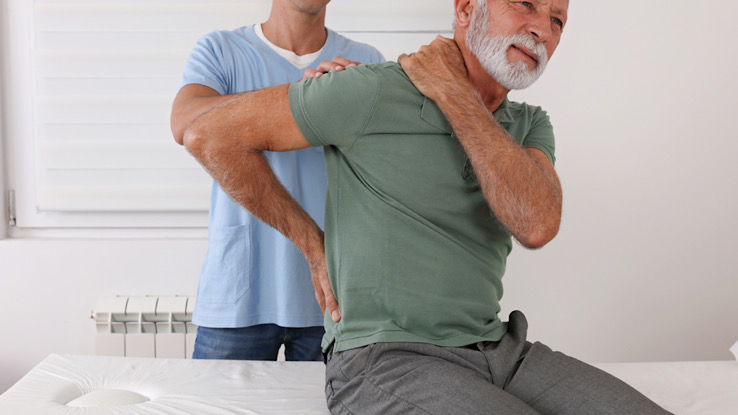Kyphosis: Causes, Symptoms, Treatments And Prevention

When you were a child, you may recall that your parents and teachers would tell you to sit up straight and not slouch. Maybe they were on to something. If you’ve ever noticed some people with a pronounced curvature of the spine at the top of their back that makes them appear to be standing hunched over, they may have a condition known as kyphosis. Kyphosis is an excessive curving of the spine that results in an abnormal rounding of the upper back. This shouldn’t be confused with scoliosis, which is a sideways curve of the spine that often resembles the letter “S.”
What Is Kyphosis?
Some curvature of the spine is normal. The spine naturally curves 20-40 degrees in the upper back area, which is kyphosis. When it’s more curved than normal, it’s called hyperkyphosis, but some people still refer to it as kyphosis. There is some variability in the literature, but hyperkyphosis is a more than normal curvature on x-ray, with the cutoff between 40 degrees and 50 degrees. If you are wondering whether you have kyphosis, your doctor can help you get the correct diagnosis. This condition occurs most commonly in older adults because of the loss of flexibility in the vertebrae, osteoporosis, and fractures.
Signs and Symptoms
The most common signs and symptoms of kyphosis are:
- Visible hump on the back
- Head bending forward
- Upper back pain
- Pain worse with movement
Other symptoms, depending on the severity of the kyphosis, can include:
- Differences in shoulder blade height
- Spine stiffness
- Fatigue
- Balance problems
- Chest pain
- Shortness of breath
Causes of Kyphosis
Kyphosis prevalence increases with age, and about 4 in 10 adults over 60 have kyphosis. Age-related kyphosis is a gradual increase in the spine curvature over time. It can be caused by problems with the spinal vertebrae (bones of the spine), discs (between the spine bones), or muscles and ligaments that support the spine.
Some problems increase the risk of age-related kyphosis, such as:
- Osteoporosis – weakens the spine bones
- Vertebral fractures – tiny cracks in the spine bones
- Degenerative disc disease – shrinking and breaking down of the disc
- Muscle weakness – less support of the spine
Some more rare types of kyphosis can present in children, such as Scheuermann’s kyphosis and congenital kyphosis, which are structural problems in the spine.
Diagnosis and Tests
When you go to your doctor for a regular check-up, they will be able to examine your spine for any abnormal curvature like kyphosis. It’s a condition that your doctor can identify during the physical exam.
If your doctor thinks you have kyphosis during your physical exam and it’s causing symptoms, they may send you for spine x-rays. The x-ray helps to show the curve of the spine. Based on the x-ray, your doctor will calculate how much curvature you have in your spine and assess whether it is considered abnormal. The x-ray will also allow your doctor to check whether there are other potential causes for your symptoms.
Treatments for Kyphosis
Treatment for kyphosis depends on what caused the kyphosis and how serious it is. Most people with kyphosis can have non-surgical procedures for treatment such as:
- Physical Therapy: Certain exercises can help strengthen the abdomen and back muscles. With strengthened muscles in these areas, you will be better able to support the spine, improve posture, and relieve any pain you are experiencing.
- Bracing: Your doctor may recommend that you wear a brace for a certain amount of hours per day to help support your spine.
- Anti-inflammatories: If your doctor approves, medicines like aspirin and ibuprofen can help relieve your back pain.
- Surgery: If your kyphosis is causing disability, breathing problems, neurological problems, or is unresolved by the treatments listed above, your doctor may recommend surgery. In a spinal fusion surgical procedure, the surgeon corrects the curvature of your spine and then fuses it in place. This comes with risks of surgery, so it is reserved for very severe cases.
Additionally, if you have risk factors contributing to your kyphosis, like osteoporosis, your doctor may also start you on medicine to treat that.
Prevention
In most cases, prevention can be as simple as heeding the advice that parents and teachers gave to children years ago: sit up straight and don’t slouch. This will maintain good posture, keep the back and abdominal muscles strong, and reduce the chances of kyphosis from developing.
Other prevention techniques are the same as those you would follow to stay in good general health:
- Perform exercises that strengthen the abdominal and back muscles
- Stay flexible with reasonable stretching exercises
- Maintain a healthy weight with good eating habits
- Lift and carry bags that are heavy with proper form to avoid injury
Next Steps
If you think you have kyphosis, talk to your doctor. It’s important to find out if you have it since the condition could get worse if left untreated.
During the appointment, your doctor will examine you to diagnose if you have kyphosis, what type of kyphosis you have, and what treatment plan will be best for you. Remember that most people with kyphosis can be treated very effectively with exercise and physical therapy. You should follow your doctor’s guidance, even though it may take a while to see the results.
Resource Links:
- “Kyphosis” via Mayo Clinic
- “The Clinical Relevance of Hyperkyphosis: A Narrative Review” via Frontiers in Endocrinology “Kyphosis” via Johns Hopkins Medicine
- “Kyphosis” via Cleveland Clinic
- “Adult Kyphosis” via University of Maryland Medical Center
- “Kyphosis (Roundback) of the Spine” via OrthoInfo
- “Age-related hyperkyphosis: its causes, consequences, and management” via JOSPT
- “Kyphosis” via StatPearls





